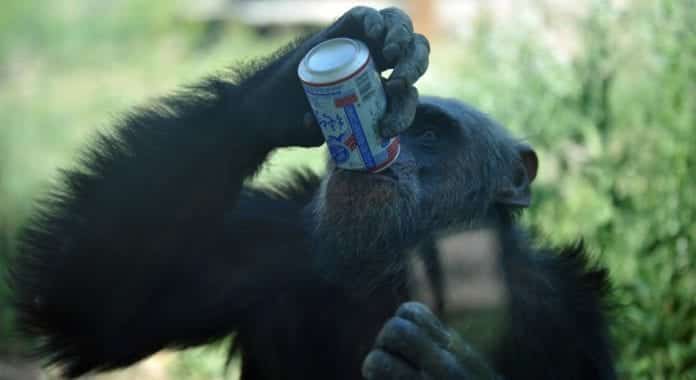Chimpanzees not only share the metacognitive behavior but also relish alcohol just like humans.
A 17 year old study carried out by scientists concluded that the wild chimpanzees indulge in regular alcohol drinking. Chimpanzees of Bossou, southeastern Guinea booze right from 7 am in the morning till night fall. These wild chimpanzees indulge in large amounts of drinks however their sessions are pretty orderly and also social.
Scientists closely observed the west African chimps in their natural habitat centered around raffia palms from 1995 to 2012 and the entire action was recorded.
The local communities in that area usually harvest sugary sap from the trees which then gets converted into an alcoholic brew within hours due to fermentation.
The extraction of the sweet white sap is done by cutting a wedge in the tree and suspending a container beneath the wedge. Tappers then leave this container there for some days and the entire arrangement is covered with leaves to keep the bugs out. With this arrangement one tree can provide around 50 liters of sap.
In the 17 year old study it was found that there were almost 51 incidents when chimps raided the palm sap containers. The smart chimpanzees usually searched for the big leaf that covered the container then they would either chew it to form a sort of absorbent sponge or fold it to form a scoop. The chimps would then insert this into the sap, take it out and drink the sap.
The entire study was published in Royal Society Open Science. During their study researchers were surprised to find that on an average the chimps were swallowing almost one liter of the fermented sap every time.
One amazing discovery was regarding a male chimpanzee, named Foaf, who appeared in 14 of the total 51 test sessions; scientists though considered him to be an outlier. The study involved 26 apes in all and of these 13 were teetotallers (meaning the ones who abstain from alcohol).
Scientists further also carried out tests to check the alcohol content in the raffia palm sap and found that the actual alcoholic percentage varied throughout the day. On an average the sap contained about 3.1% alcohol by volume (ABV) which is equivalent to pint of Bass mild. Scientists also found that the most potent sap contained 6.9% ABV which can be considered equivalent to Brooklyn East India Pale Ale.
An amazing fact revealed by the study was that male and female chimps equally relished alcohol with the only variation being the amount of consumption and that too depended on the individual ape.
Kimberley Hockings, who is a part of the study at Oxford Brookes University indicated that the amount of alcohol consumed by the apes are sure to bring about “elicit behavioural changes in humans”; however he said that it is not yet sure if the chimps reached that level after boozing.
During their study, scientists noticed that at one event an adult male seemed to be very restless after boozing though rest of his companions went to their nests after the boozing session. This male ape literally showed erratic behavior by swinging from tree to another for almost an hour, it seemed that it was in an agitated mood.
The ‘Drunken Monkey Hypothesis’ was proposed by Dr Robert Dudley who was from the University of California at Berkeley. This hypothesis proposed that human attraction to ethanol is basically due to the dependence of their primate ancestors on ripe and fermenting fruit as their utmost source of food. Basically, ethanol is found in ripe and over ripe fruits which occurs due to fermentation of sugar by yeast. Thus the hypothesis suggested that early primates genetically evolved some taste for the alcohol as it not only stimulated their appetite but also helped them hunt for fruit and boosted the intake of calories.
It seems some 10 million years ago, the ancestors of apes and humans together underwent some genetic mutation which resulted in an improved ability to break down ethanol, thus it explains why humans and apes can consume large amounts of alcohol because without this evolution consuming alcohol could be much dangerous.
Way back in 2008, a research team in US had reported chronic alcoholic drinking in wild tree shrews. The authors mentioned: ‘It is yet unclear to what extent tree shrews benefit from ingested alcohol per se, and how they mitigate the risk of continuous high blood alcohol concentrations.’
In another instance, green monkeys were found to steal the cocktails of tourists in St Kitts.
Mareile Flitsch, director of the Ehtnographic Museum of the University of Zürich said that drinking the palm sap before it fermented too much is a real challenge because once the fermentation exceeds it gets converted into vinegar. She says: “It’s very nice when it’s fresh. It tastes like cider.”
All these evidences show that chimpanzees of Bossou are not the first ones to be caught stealing and relishing the fermented sap.
Dr Catherine Hobaiter, from St Andrews University, said: “It would be fascinating to investigate the [behaviour] in more detail: do chimps compete over access to the alcohol? Or do those who drank enough to show ‘behavioral signs of inebriation’ have a bit of a slow day in the shade the next morning?”
Dr Hobaiter further says that even after studying chimpanzees for over 60 years, they can still surprise the researchers!!

